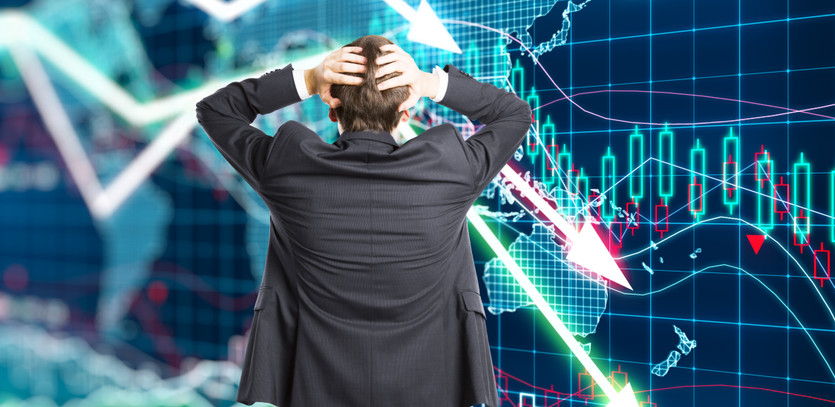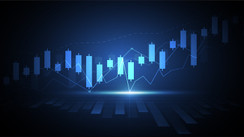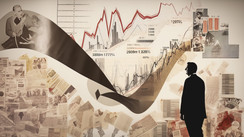In the world of electronic trading, a phenomenon known as a flash crash occurs when a market's value abruptly and sharply drops within a limited timeframe. This rapid plunge is typically triggered by electronic, automated trading.
Flash crashes often result from an immense block of trades that stir computerized trading programs into action. These programs, or bots, swiftly respond to sell orders or other market anomalies, thus intensifying the effect of the crash.
The First Flash Crash and Its Aftermath
The birth of the flash crash concept came on May 6, 2010, when the Dow Jones Industrial Average fell nearly 1,000 points in a matter of 10 minutes, obliterating $1 trillion in equity. However, by day's end, the market had recouped most of its losses.
During this event, the euro nosedived against the dollar, while gold soared to $1,200 an ounce and the 10-year Treasury note yield decreased to 3.4%. It's noteworthy that the opposite of a flash crash, where prices in a market rapidly inflate, is occasionally referred to as a flash spike.
The Mechanics Behind Flash Crashes
Understanding the mechanism behind flash crashes is crucial to comprehend the dynamics of modern financial markets. As investors, we should be well-aware of how and why these sudden drops in market value occur.
A typical flash crash is often triggered by a substantial block of trades, which can create a domino effect in the market. In our current era of electronic trading, computer algorithms, or "bots," play a significant role in amplifying these incidents. These bots operate based on predefined algorithms designed to spot abnormalities in the market, such as an influx of sell orders. In response to these signals, they execute automated sell orders to mitigate potential losses, exacerbating the initial drop in the market.
The role of these bots is pivotal in shaping the intensity of a flash crash. They're coded to respond to unusual market movements or even global events, meaning they can react to a wide range of triggers. This responsiveness makes any market movement more intense and adds to the inherent risk of trading.
While a flash crash can stir panic, it's important to note that these incidents usually reflect technical glitches rather than a loss of confidence in the economy. However, a prolonged or severe flash crash could potentially undermine confidence if it leads to significant wealth destruction or deters consumers from spending. In a worst-case scenario, a flash crash could even tip the balance and trigger a recession if it happens at a delicate phase in the business cycle.
On the flip side of flash crashes are the less common but equally dramatic "flash spikes," where market prices surge rapidly. Also, "mini flash crashes," which refer to rapid drops in the prices of individual securities or futures, occur more frequently.
This understanding of the underlying mechanics of flash crashes reveals a complex interplay between technology and market behavior. As we navigate this evolving landscape, it's essential for traders and investors to be aware of these phenomena, understand their triggers, and devise strategies to manage the associated risks.
A Chronicle of Memorable Flash Crashes
The history of flash crashes in the new millennium is as varied as it is intriguing, impacting different markets and sparking debates about market structures and the role of automation in trading. Here is a closer look at some of the most significant incidents:
-
The 2017 Ethereum Flash Crash
On June 22, 2017, the Global Digital Asset Exchange (GDAX) bore witness to a striking event in the world of cryptocurrency. The price of Ethereum, one of the leading digital currencies, plummeted from a substantial $319 to a mere 10 cents in a matter of seconds. This sudden drop, while momentary, resulted in significant losses for some investors while creating an unexpected windfall for others who had set low buy orders.
-
The 2022 European Stock Market Flash Crash
This flash crash, occurring on May 2, 2022, sent shockwaves through the European stock market, causing unexpected volatility. In what was later termed as "the fat finger crash," an erroneous input by a Citigroup trader caused an abrupt downturn in several European stocks. The error was soon identified and rectified by Citigroup, which helped stabilize the market and restored investors' confidence.
-
The 2015 NYSE Flash Crash
One of the more dramatic events took place on July 8, 2015, when the New York Stock Exchange (NYSE) halted trading for three hours and 38 minutes. Trading swiftly transitioned to the 11 other exchanges, such as NASDAQ and BATS, along with numerous "dark pools". As a result, NYSE lost 40% of its trading volume. The reason behind the shutdown remains a mystery, with speculation linking it to the closure of the Wall Street Journal's homepage or the grounding of United Airlines flights, both of which occurred on the same day.
-
The 2014 Bond Flash Crash
This particular flash crash, on Oct. 15, 2014, greatly impacted the bond market. The yield on the 10-year Treasury note took a nosedive from 2.02% to 1.86% within a few short minutes, only to quickly rebound. The swift drop in yield indicated an unexpected surge in demand for these notes. Many attributed this event to algorithm-based trading programs that managed a majority of trading in U.S. Treasury notes.
-
The 2010 Dow Flash Crash
The event that birthed the term "flash crash" occurred on May 6, 2010, when the Dow Jones Industrial Average (DJIA) plummeted by 1,000 points within 10 minutes, marking the biggest point drop on record and wiping out $1 trillion in equity. It was later discovered that a trader named Navinder Sarao, operating from his suburban home in London, had placed and swiftly cancelled hundreds of "E-mini S&P" futures contracts. This incident highlighted the potential for market manipulation through practices like "spoofing," where market prices are artificially inflated, then quickly sold for a profit.
These flash crashes serve as reminders of the susceptibility of modern markets to rapid, automated trading actions and the potential for sudden market movements. As investors and regulators alike continue to navigate this complex landscape, these historic incidents offer valuable lessons about market behavior, risk, and the importance of safeguards in electronic trading.
Are Financial Markets Rigged?
The world of financial markets, where fortunes are made and lost within seconds, has always been a subject of fascination and scrutiny. An important question that has sparked countless debates and discussions is: Is the stock market rigged against the individual investor?
Critics argue that the presence of high-frequency trading (HFT) programs gives certain entities an unfair advantage. These sophisticated computer programs can analyze vast amounts of data and make trading decisions in a split second, far quicker than any human.
Renowned author, Michael Lewis, voiced this concern in his book, "Flash Boys." He boldly claimed that this technological edge has skewed the playing field in favor of companies that employ these tools. Notably, powerhouse financial institutions like Goldman Sachs and JP Morgan have leveraged HFT to such an extent that they've reportedly not lost on a trade in years.
Lewis's claims stirred up a storm in the financial world. He defended his research in a heated exchange with the CEO of BATS, the second-largest exchange behind the NYSE, on a CNBC segment. BATS, like NASDAQ, is an all-electronic exchange but with a larger market share.
The debate around market manipulation through HFT can leave individual investors feeling helpless. The speed and data-processing capabilities of these programs far exceed what any human trader can manage. Further adding to the skepticism is the lack of regulation surrounding these algorithms, leading many to question the fairness of contemporary trading practices.
However, it's essential to understand that all is not lost for individual investors. Outperforming these HFT programs on a daily basis might be an uphill task, but one can still navigate the market successfully by focusing on the bigger picture.
Keeping an eye on the overall trajectory of the business cycle and maintaining a diversified portfolio are effective strategies for the individual investor. Regularly adjusting your asset allocation can yield decent returns, despite the presence of high-speed trading bots. Remember, in the world of investing, it's not always about how much you make but how much you manage to keep. In essence, even in a world teeming with high-frequency trades, prudent investing strategies remain a viable path for individual investors.
Flash Crashes and Their Impact on You
While Wall Street may not be intentionally rigged, it can certainly feel that way for individual investors who can't compete with the information-processing capabilities of trading bots. These programs have the potential to cause dramatic market shifts that can affect everyone.
Despite this, there are still ways for individual investors to navigate the markets successfully. By tracking the business cycle, maintaining a diversified portfolio, and adjusting asset allocation each quarter, you can aim to secure a reliable return. Remember, it's not about how much you earn, but how much you manage to keep.





